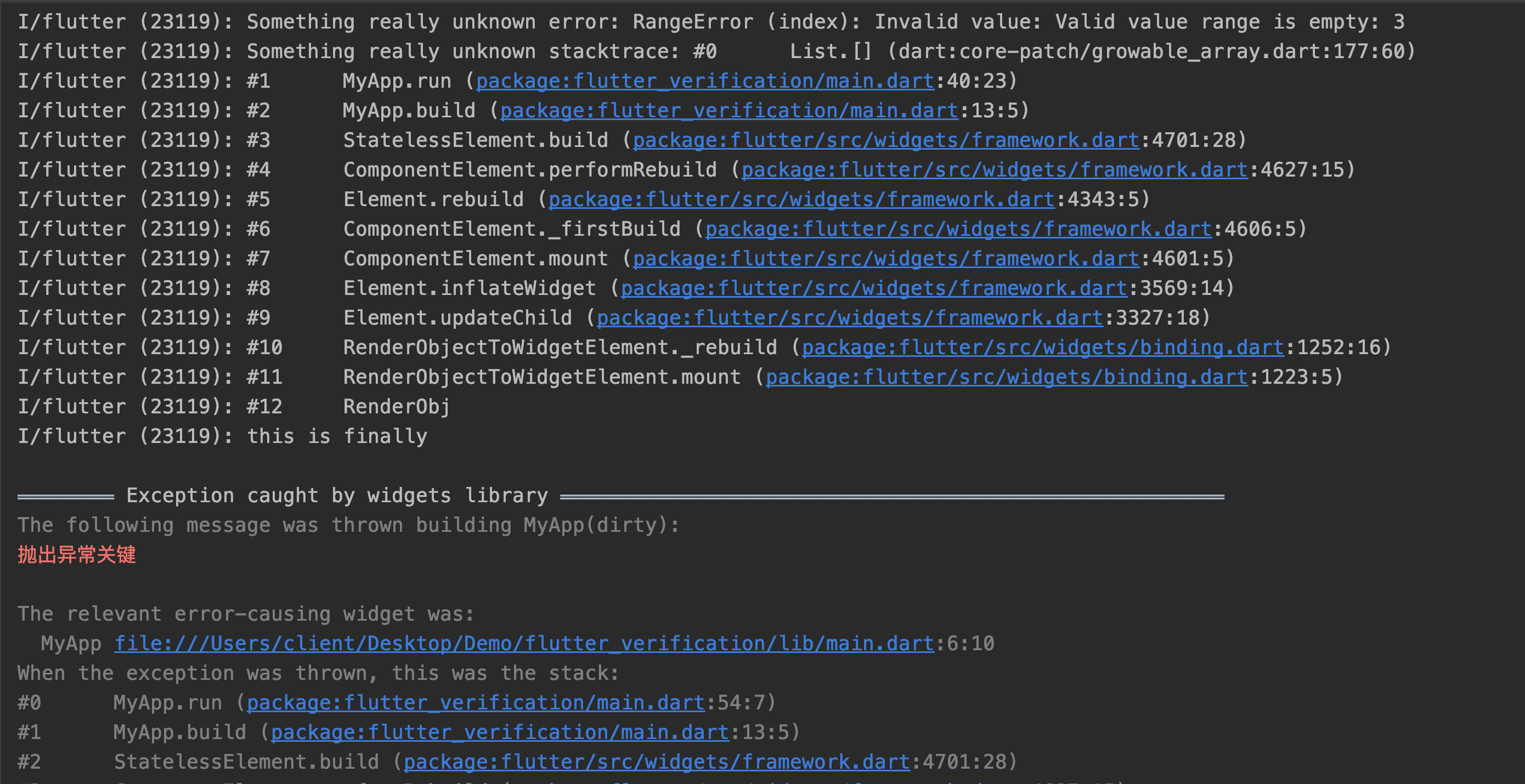一、Dart 异常捕获、抛出
在Dart中,异常分两类:同步异常和异步异常
1、同步异常:
Dart中同步异常可以通过try/on/catch/finally来捕获代码块异常,可以通过throw 关键字用来明确地抛出异常。如下案例:
List testList = List(); try { var s = testList[3]; //代码逻辑 } on IntegerDivisionByZeroException { //使用on关键字,捕获特定类型的异常 } on NoSuchMethodError catch (e) { //使用on关键字,捕获特定类型的异常 //代码段可以有多个 on / catch 块来处理多个异常 } catch (error, stacktrace) { // 没有指定类型,处理所有错误 //catch 最多提供两个可选参数 //第一个参数 error 类型为 Object,也就是异常是可以抛出任意对象。 //第二个参数 stacktrace,表示异常堆栈。 print('Something really unknown error: $error'); print('Something really unknown stacktrace: $stacktrace'); throw '抛出异常关键'; //throw 之后的代码将不会执行 //throw new FormatException(); } finally { // 在throw之前先执行finally代码块 print("this is finally"); }
输出结果:

Dart中的每个异常类型都是内置类 Exception 的子类型。Dart可以通过扩展现有异常来创建自定义异常。定义自定义异常的语法如下所示
语法:定义异常
class Custom_exception_Name implements Exception { // can contain constructors, variables and methods }
eg: class AmtException implements Exception { String errMsg() => 'Amount should be greater than zero'; } throw new AmtException();
2、异步异常
try-catch 代码块不能捕获到异步异常,使用 await 关键字声明的同步调用,属于同步异常范围,可以通过 try-catch 捕获。
使用 catchError 捕获异步异常,第一个参数为 Function error 类型,第二个参数为 {bool test(Object error)},是一个判断表达式,当此表达式返回值为 true 时,表示需要执行 catch 逻辑,如果返回 false,则不执行 catch 逻辑,即会成为未捕获的异常,默认不传时 认为是true。
这里的作用是可以精细化的处理异常,可以理解为同步异常中强化版的 on 关键字,
入参至多两个 分别为error 和 stack,均可选。
Future(() {
}).then((value){ }).catchError((error, stack) { }); Future.delayed(Duration(seconds: 1)).then((e) => Future.error("xxx"));
二、Flutter异常捕获、抛出
为了捕获并上报异常,可以把应用运行在一个自定义的 Zone 里面。 Zones 为代码建立执行上下文环境。在这个上下文环境中,所有发生的异常在抛出 onError 时都能够很容易地被捕获到。
Dart中有一个runZoned(...) 方法,可以给执行对象指定一个Zone。Zone表示一个代码执行的环境范围,为了方便理解,读者可以将Zone类比为一个代码执行沙箱,不同沙箱的之间是隔离的,沙箱可以捕获、拦截或修改一些代码行为,如Zone中可以捕获日志输出、Timer创建、微任务调度的行为,同时Zone也可以捕获所有未处理的异常。下面我们看看runZoned(...)方法定义:
R runZoned<R>(R body(), {
Map zoneValues,
ZoneSpecification zoneSpecification,
Function onError,
})
参数含义可参考《Flutter实战》https://book.flutterchina.club/chapter2/thread_model_and_error_report.html
在下面的例子中,将会把应用运行在一个新的 Zone 里面并捕获所有错误,在 1.17 之前的 Flutter 版本里,你可以通过 onError() 回调捕获所有的异常。
runZoned<Future<void>>(() async { runApp(MyApp()); }, onError: (error, stackTrace) { // Whenever an error occurs, call the `_reportError` function. This sends // Dart errors to the dev console or Sentry depending on the environment. _reportError(error, stackTrace); });
在包含了 Dart 2.8 的 Flutter 1.17 中,使用 runZonedGuarded:
runZonedGuarded<Future<void>>(() async { runApp(MyApp()); }, (Object error, StackTrace stackTrace) { // Whenever an error occurs, call the `_reportError` function. This sends // Dart errors to the dev console or Sentry depending on the environment. _reportError(error, stackTrace); });
除了 Dart 异常,Flutter 也能抛出其他的异常,比如调用原生代码发生的平台异常。这种类型的异常也同样是需要上报的。
为了捕获 Flutter 异常,需要重写 FlutterError.onError 属性。在开发环境下,可以将异常格式化输出到控制台。在生产环境下,可以把异常传递给上个步骤中的 onError 回调。
大致步骤如下:
Future<Null> main() async { //重写FlutterError.onError FlutterError.onError = (FlutterErrorDetails details) { if (isInDebugMode) { // In development mode, simply print to console. FlutterError.dumpErrorToConsole(details); } else { // In production mode, report to the application zone to report to // Sentry. Zone.current.handleUncaughtError(details.exception, details.stack); } }; //使用runZonedGuarded捕获日志输出、Timer创建、微任务调度的行为、所有未处理的异常 runZonedGuarded<Future<Null>>( () async { runApp(MyApp()); }, (error, stackTrace) async { await _reportErrorAndLog(error, stackTrace); }, zoneSpecification: ZoneSpecification( print: (Zone self, ZoneDelegate parent, Zone zone, String line) async { await collectLog(line); // 收集日志 }, ), ); } Future<Null> collectLog(String line) async { //收集日志 } //上报错误和日志逻辑 Future<Null> _reportErrorAndLog(dynamic error, dynamic stackTrace) async { print('Caught error: $error'); if (isInDebugMode) { print(stackTrace); print('In dev mode. Not sending report to Sentry.io.'); return; } //TODO: response 为上传请求结果 if (response.isSuccessful) { print('Success!'); } else { print('Failed to report to Sentry.io: ${response}'); } } //判断debug及release环境 bool get isInDebugMode { bool inDebugMode = false; assert(inDebugMode = true); return inDebugMode; }
参考:
https://book.flutterchina.club/chapter2/thread_model_and_error_report.html
https://flutter.cn/docs/cookbook/maintenance/error-reporting#5-catch-and-report-dart-errors
https://juejin.cn/post/6906274131394691085